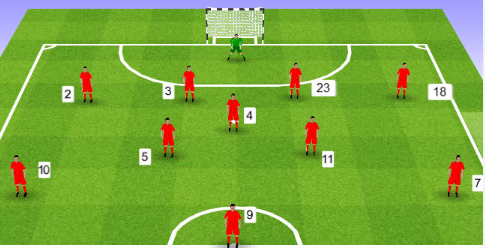Football Tactics & Strategies-Football is more than just a game of strength and skill—it’s like playing chess on the field. Coaches and players constantly improve their tactics and strategies to outsmart their opponents and create brilliant moments. In this blog, we will explore how football tactics have evolved, key formations, and strategies that have shaped the modern game.
1. A Historical Perspective on Football Tactics
Early Formations and Evolution
- The W-M Formation:
In the early 20th century, teams commonly used the W-M formation, which helped balance attack and defense. This system laid the groundwork for future tactical innovations. - Catenaccio and Defensive Mastery:
In the 1960s and 1970s, Italian teams popularized catenaccio, a tactical system emphasizing strong defensive organization and swift counter-attacks. - The Emergence of Total Football:
The Dutch revolutionized football with Total Football in the 1970s, a fluid system where players interchanged positions, promoting flexibility and collective responsibility.
2. Modern Formations: The Blueprint of Success
Popular Formations Today
- 4-3-3:
A balanced formation that offers width in attack and solidity in defense. It encourages quick transitions and fluid play, making it a favorite for teams focused on possession and high pressing. - 4-2-3-1:
This formation provides a strong defensive base with two holding midfielders, while the attacking trio supports a lone striker. It allows for both counter-attacking and controlled build-up play. - 3-5-2:
Increasingly popular among teams looking for midfield dominance, this formation uses three central defenders, five midfielders, and two forwards to overload the middle of the pitch and create numerical advantages.
Tactical Flexibility
Modern managers often adjust formations mid-game, depending on the scoreline or opponent’s tactics. Flexibility is key—players are expected to adapt to various roles and switching formations to gain a competitive edge.

3. Key Tactical Approaches in Modern Football
Possession-Based Play
- Tiki-Taka:
Made famous by FC Barcelona and the Spanish national team, tiki-taka relies on short, quick passes and constant movement to maintain possession and break down defenses. - Controlled Build-Up:
Emphasizing patient ball circulation, this strategy aims to draw opponents out of position before launching a decisive attack.
High Pressing and Counter-Pressing (Gegenpressing)
- High Press:
Teams force opponents to make mistakes by aggressively pressing high up the pitch, disrupting their build-up play. - Counter-Pressing:
When possession is lost, players immediately pressure to win the ball back, minimizing the time opponents have to organize their attack.
Defensive Solidity and Compactness
- Organized Defense:
A well-structured defense is essential. Modern teams focus on compactness, ensuring minimal space is available for opponents to exploit. - Zonal Marking vs. Man-to-Man:
Depending on the opposition, teams might switch between zonal marking (guarding spaces) and man-to-man marking (tracking individual players) to neutralize threats effectively.
4. The Role of Data and Technology
Data-Driven Decision Making
- Performance Analytics:
Coaches and analysts now use advanced data analytics to monitor player performance, track movements, and adjust tactics in real-time. - Video Analysis:
Detailed video breakdowns help teams study opponents, refine set-pieces, and identify tactical weaknesses.
Technology in Training
- Wearable Devices:
GPS trackers and heart-rate monitors provide insights into player workload and physical performance, aiding in injury prevention and recovery. - Virtual Reality (VR):
VR technology is being used to simulate game scenarios, helping players improve decision-making and tactical understanding without the physical strain.
5. The Future of Football Tactics
The future promises further integration of technology and evolving tactical approaches:
- AI and Machine Learning:
With AI-driven analytics, teams can predict opposition moves, optimize formations, and tailor training regimes to maximize performance. - Global Tactical Exchange:
As football becomes more interconnected, ideas and strategies from different leagues and cultures will continue to blend, creating innovative tactical paradigms.
personal Review
Football tactics and strategies have changed a lot over the years, making the modern game more tactical and exciting. The 4-3-3 formation is widely used, the False 9 role brings smart tactics, and Gegenpressing adds an aggressive style of play. Wingbacks are now key players in both attack and defense, and set pieces have become crucial for teams that use them well. These new tactics have made football faster, more unpredictable, and exciting, forcing managers, players, and analysts to constantly adapt to stay ahead.
Conclusion
Football tactics and strategies have moved from simple formations to complex systems powered by data and technology. Today’s game combines art and science, where every pass, press, and movement is planned to outsmart the opponent. Whether it’s the fast, intense press or the careful build-up play, understanding these tactics is essential to appreciating the beauty and depth of football.
What tactics do you think will dominate the future of football? Share your thoughts in the comments below!
To read more interesting articles on football/soccer please click the below links
Historical & Legendary Moments in Football
The Growth of Women’s Football
Frequently Asked Questions (FAQs)
1. What makes the 4-3-3 formation so effective?
The 4-3-3 formation is effective because it provides a balanced approach to both attack and defense, allows for fluid midfield play, and facilitates high pressing.
2. Who are some of the best False 9 players in football history?
Notable False 9 players include Lionel Messi, Francesco Totti, and Cesc Fàbregas, who have all played the role with great success.
3. What are the main advantages of Gegenpressing?
Gegenpressing forces quick turnovers, disrupts the opponent’s build-up play, and creates high-quality goal-scoring opportunities.
4. Why are wingbacks important in modern football?
Wingbacks provide width, defensive support, and attacking contributions, making them crucial in formations like the 3-5-2 and 3-4-3.
5. How can teams improve their set-piece effectiveness?
Teams can improve their set-piece effectiveness through detailed planning, precise execution, and utilizing aerially strong players in attacking positions.
